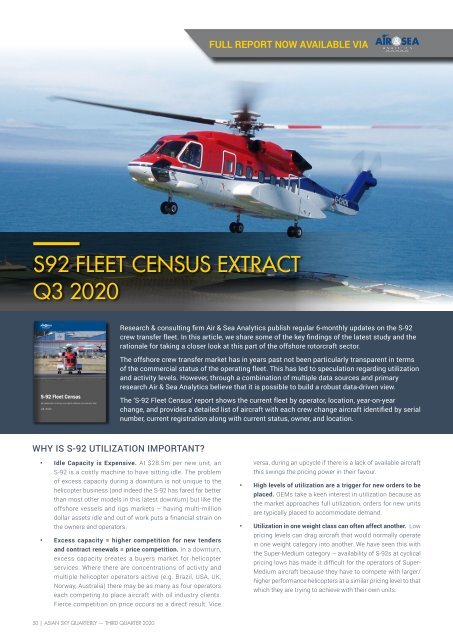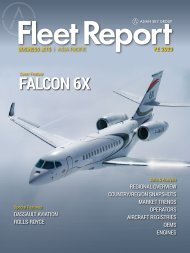You also want an ePaper? Increase the reach of your titles
YUMPU automatically turns print PDFs into web optimized ePapers that Google loves.
FULL REPORT NOW AVAILABLE VIA<br />
S92 FLEET CENSUS EXTRACT<br />
<strong>Q3</strong> <strong>2020</strong><br />
Research & consulting firm Air & Sea Analytics publish regular 6-monthly updates on the S-92<br />
crew transfer fleet. In this article, we share some of the key findings of the latest study and the<br />
rationale for taking a closer look at this part of the offshore rotorcraft sector.<br />
The offshore crew transfer market has in years past not been particularly transparent in terms<br />
of the commercial status of the operating fleet. This has led to speculation regarding utilization<br />
and activity levels. However, through a combination of multiple data sources and primary<br />
research Air & Sea Analytics believe that it is possible to build a robust data-driven view.<br />
The ‘S-92 Fleet Census’ report shows the current fleet by operator, location, year-on-year<br />
change, and provides a detailed list of aircraft with each crew change aircraft identified by serial<br />
number, current registration along with current status, owner, and location.<br />
WHY IS S-92 UTILIZATION IMPORTANT?<br />
• Idle Capacity is Expensive. At $28.5m per new unit, an<br />
S-92 is a costly machine to have sitting idle. The problem<br />
of excess capacity during a downturn is not unique to the<br />
helicopter business (and indeed the S-92 has fared far better<br />
than most other models in this latest downturn) but like the<br />
offshore vessels and rigs markets – having multi-million<br />
dollar assets idle and out of work puts a financial strain on<br />
the owners and operators.<br />
• Excess capacity = higher competition for new tenders<br />
and contract renewals = price competition. In a downturn,<br />
excess capacity creates a buyers market for helicopter<br />
services. Where there are concentrations of activity and<br />
multiple helicopter operators active (e.g. Brazil, USA, UK,<br />
Norway, Australia) there may be as many as four operators<br />
each competing to place aircraft with oil industry clients.<br />
Fierce competition on price occurs as a direct result. Vice<br />
versa, during an upcycle if there is a lack of available aircraft<br />
this swings the pricing power in their favour.<br />
• High levels of utilization are a trigger for new orders to be<br />
placed. OEMs take a keen interest in utilization because as<br />
the market approaches full utilization, orders for new units<br />
are typically placed to accommodate demand.<br />
• Utilization in one weight class can often affect another. Low<br />
pricing levels can drag aircraft that would normally operate<br />
in one weight category into another. We have seen this with<br />
the Super-Medium category – availability of S-92s at cyclical<br />
pricing lows has made it difficult for the operators of Super-<br />
Medium aircraft because they have to compete with larger/<br />
higher performance helicopters at a similar pricing level to that<br />
which they are trying to achieve with their own units.<br />
50 | ASIAN SKY QUARTERLY — THIRD QUARTER <strong>2020</strong>

















